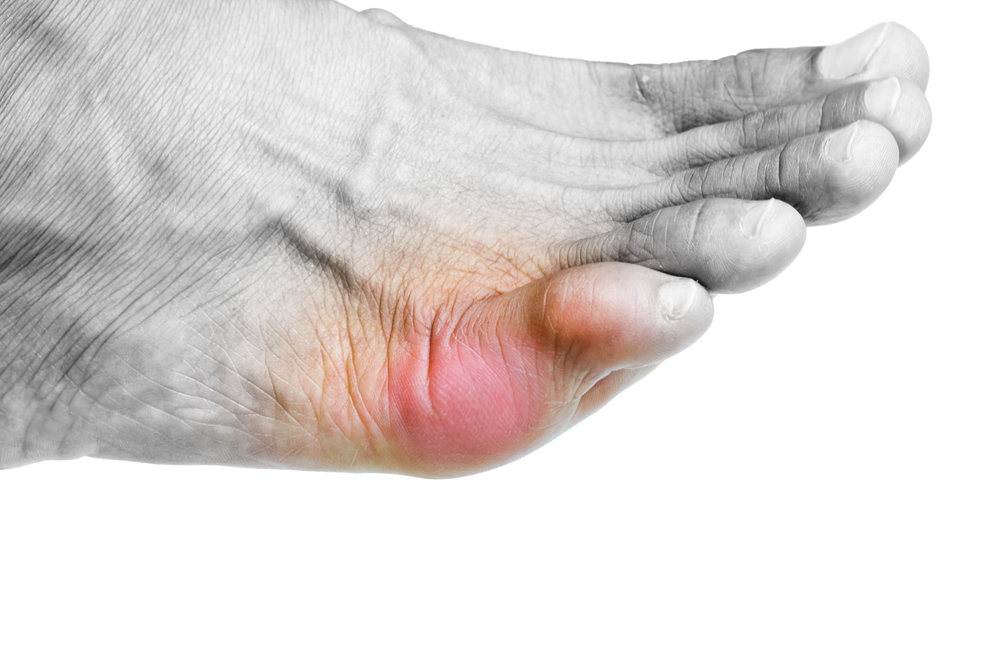
Gout is the most common cause of inflammatory arthritis worldwide. It is on the increase with our ageing population, changes in diet and lifestyle, and an increase in obesity, metabolic syndrome and diabetes. Raised serum uric acid (SUA), male gender, menopausal status in females, alcohol, high blood pressure, kidney problems and some medication (e.g. diuretics) are also risk factors for gout.
Gout is caused by deposition of mono sodium urate (MSU) crystals in and around joints, which can cause flares of acute inflammation with red, hot, painful, swollen joints. The majority of patients have a history of acute gout affecting the base of big toes, also known as podagra.

Podagra
Recurrent attacks are common, and can affect almost any joint, although lower limb involvement is more common. If high levels of uric acid are left untreated, recurrent attacks are likely to occur which may eventually lead to chronic tophaceous gout.

Chronic tophaceous gout
The diagnosis is helped by raised SUA although it may be normal during an acute attack. Patients often have an inflammatory response, with raised inflammatory markers on blood tests (CRP and ESR). Identification of MSU crystals in joint and tissue samples is the ‘gold standard’ for diagnosis, but is not always practical in the community setting. Repeated attacks of inflammation may lead to joint damage.
Modern imaging techniques, such as joint ultrasound scan and DECT (Dual Energy CT) scan, can also help to diagnose challenging cases. It is important to differentiate gout from joint infection, which may also occur at the same time. Psoriatic arthritis, pseudogout and palindromic rheumatoid arthritis are in the differential diagnoses.
Lifestyle advice
Lifestyle advice is key, including weight reduction, reduced alcohol intake, a low purine diet and avoiding dehydration. Blood pressure, blood sugar and lipids should be checked also. An alternative blood pressure medication can be considered for those on diuretics for their high blood pressure.
A well-balanced diet low in fat and added sugars, and high in vegetables and fibre should be encouraged. Sugar-sweetened soft drinks containing fructose, excessive intake of alcoholic drinks and high purine foods should be avoided. Inclusion of skimmed milk and/or low-fat yoghurt, soybeans and vegetable sources of protein and cherries in the diet should be encouraged.
Treatment of acute gout
Patients should be treated as soon as an attack occurs. Affected joints should be rested and elevated. Ice packs can also help. A non-steroidal anti-inflammatory drug (NSAID) or colchicine are the drugs of choice depending on comorbidities. When they fail or are contraindicated, steroids (by mouth, in the joint or in the muscle) may be considered. Combinations of therapy can also be used. The IL-1 inhibitor, anakinra may be considered when standard treatments fail.
Urate-lowering drugs (ULDs)
When the acute attack is over, ULDs should be considered. Low-dose colchicine or an NSAID when starting ULDs is recommended as a preventative treatment against acute attacks. ULDs should not be stopped during acute attacks if a patient is already on this.
The first-line ULD is allopurinol. When allopurinol fails or if it is not tolerated, febuxostat (an alternative xanthine oxidase inhibitor) should be considered.
Uricosuric agents can be used in patients who are resistant to, or intolerant of, xanthine-oxidase inhibitors. The preferred drugs are sulfinpyrazone or probenecid in patients with normal or mildly-impaired kidney function, or benzbromarone in patients with mild-moderate kidney insufficiency.
In summary…
Gout is common but often undertreated despite available treatments. It is important to make an accurate diagnosis and screen patients for associated conditions and secondary causes. Gout in the young, transplant and elderly patients, and those with kidney dysfunction can be challenging and may require input from secondary care.
